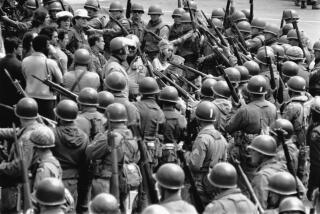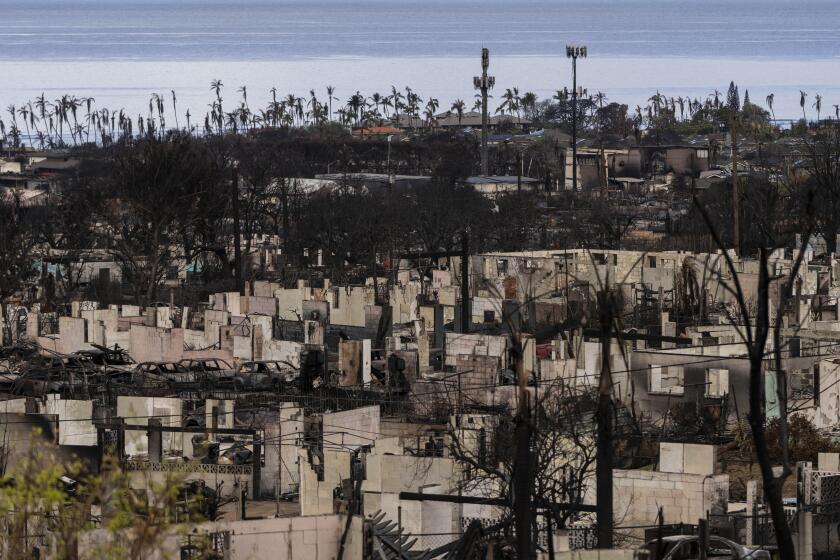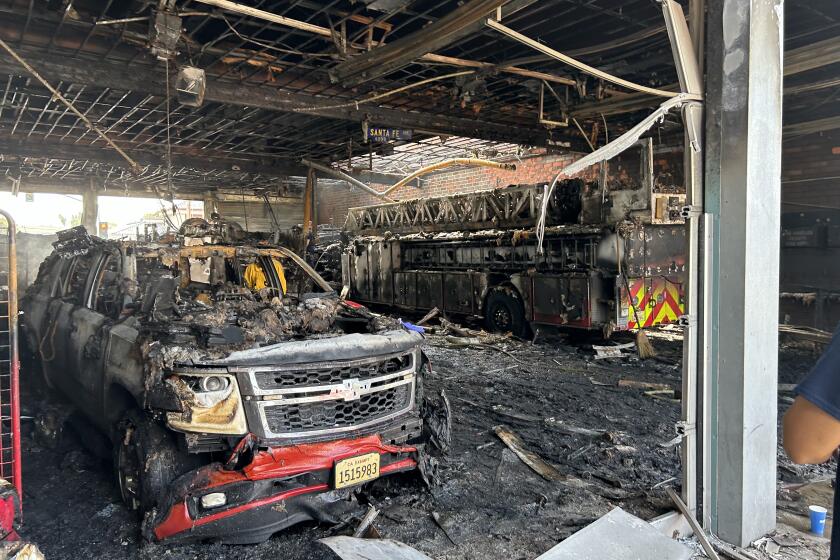Rain Departs, Leaving Behind Muddy Mess
A powerful Pacific storm finally abandoned Southern California on Tuesday afternoon, leaving behind a Burbank canyon awash with mud and water that cascaded down hillsides denuded during one of last month’s wildfires.
“We got evacuated in the fire. Then we had the rain and mud. The locusts come next,” said Jack Gagne, 48, a “Tonight Show” cameraman who moved to Deer Creek canyon a year ago. But, he added as he shoveled the muck from his driveway, “to live in this beautiful canyon is totally worth it.”
The neighborhood of substantial, secluded homes remained closed to all but foot traffic Tuesday as city workers used massive front-loaders to scoop up and haul away the mess.
Several longtime residents said the danger and inconvenience come with the territory.
“It’s a perfect place to live except for the natural disasters,” said Rachel Strutt, 32, who has lived in the same house for 30 years. “We’ll wake up to go to school and there will be deer crossing the street. You’re so close to the city and there’s no traffic, no noise, no crime.”
But one canyon dweller who has lived there eight years was less enchanted as he strode down the cluttered street.
“This is kind of scary,” said the middle-aged man, who declined to give his name. “We want to sell the house. Who knows what will happen next.”
A general evacuation briefly contemplated by the city Monday was canceled because no structures were endangered, Burbank Police Sgt. Carlos Gomez said.
Monday’s flood crashed through many frontyards, gardens and driveways, depositing up to 3 feet of mud. Several parked cars were carried as far as 50 yards.
But the canyon’s 60 or so houses suffered little damage because they are built on terraced slopes just above the one-lane road that does double duty as a flood channel.
Jim Kenahan, a retired aerospace manager who has lived in the canyon for 38 years, said the swirling river of mud “sounded like a freight train” Monday as he watched from a knoll next to his driveway.
“This has happened about eight times since I’ve been here,” he said. “Ten or fifteen minutes after a downpour like we had, the water will sweep through this canyon.
“They talk about sandbags and stuff like that, but there’s nothing that can stop it.”
In Riverside County’s Coachella Valley, storm runoff a foot deep swamped three homes in Thousand Palms, displacing about a dozen residents, the Riverside County Fire Department said.
Ten homes in nearby Desert Hot Springs were threatened by rising floodwaters, but damage was minor and no evacuations were necessary, officials said.
The Alaskan storm, which struck Southern California a glancing blow on Saturday night, gathered strength over the ocean on Sunday before returning with a vengeance Sunday night, dropping more than 3 inches of rain in some areas and pelting foothill communities with hail the size of walnuts.
Thunder rumbled throughout the Southland, and officials said a man was knocked unconscious Monday when lightning struck the oil platform where he was working off the Ventura County coast.
Mudslides closed Interstate 5 in the Grapevine area Monday night, and traffic was diverted for about seven hours before all lanes reopened about 4 a.m. Tuesday.
The storm moved out to the east late Tuesday, leaving behind the prospect of mostly sunny skies and seasonably comfortable temperatures for the rest of the week.
Storm totals as of noon Tuesday included 3.09 inches in Altadena, 2.87 at the Santa Anita Dam above Sierra Madre, 2.44 in Pacoima, 1.77 in Eagle Rock, 1.73 in Claremont, 1.60 in Van Nuys and 1.30 in downtown Los Angeles.
The storm raised the downtown total for the season, which runs from July 1 through June 30, to 1.64 inches. The normal season’s total through Oct. 18 is .63 of an inch.
*
Times staff writer Susannah Rosenblatt in Riverside and Associated Press contributed to this report.
More to Read
Start your day right
Sign up for Essential California for news, features and recommendations from the L.A. Times and beyond in your inbox six days a week.
You may occasionally receive promotional content from the Los Angeles Times.






